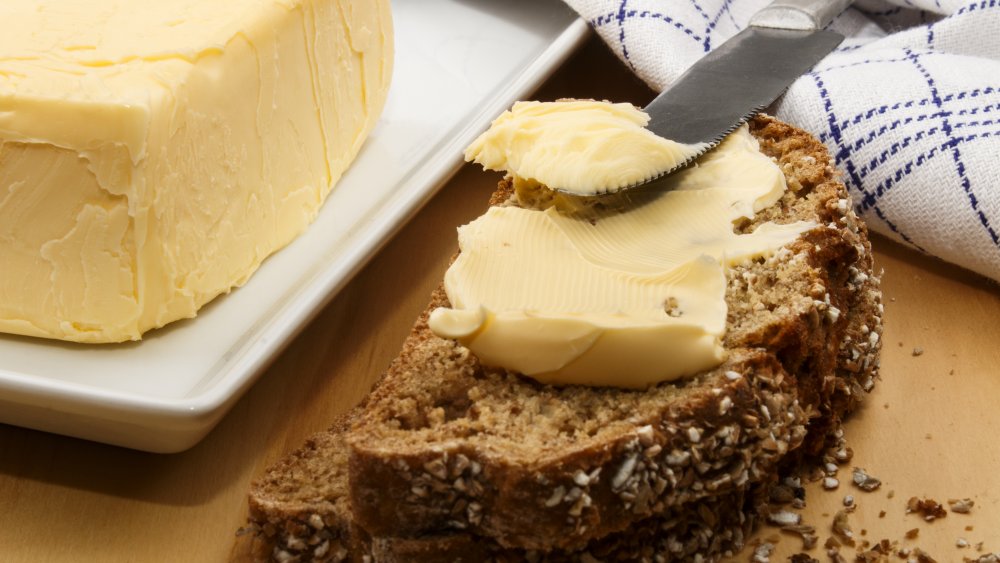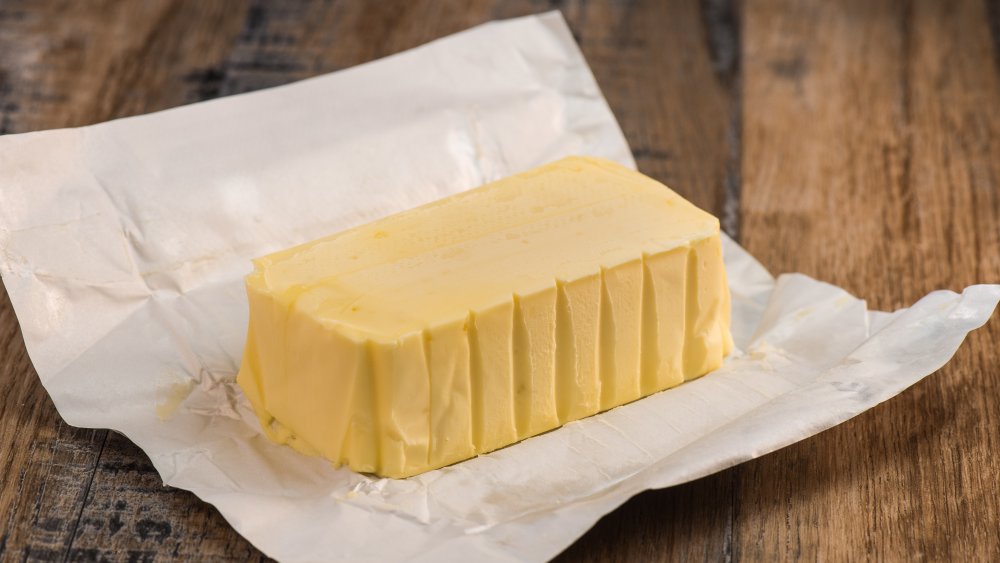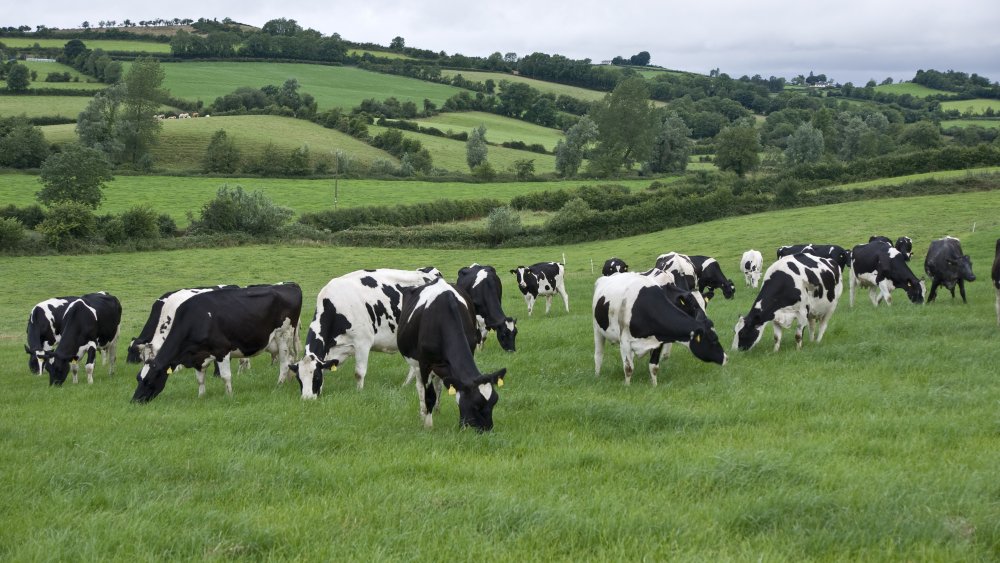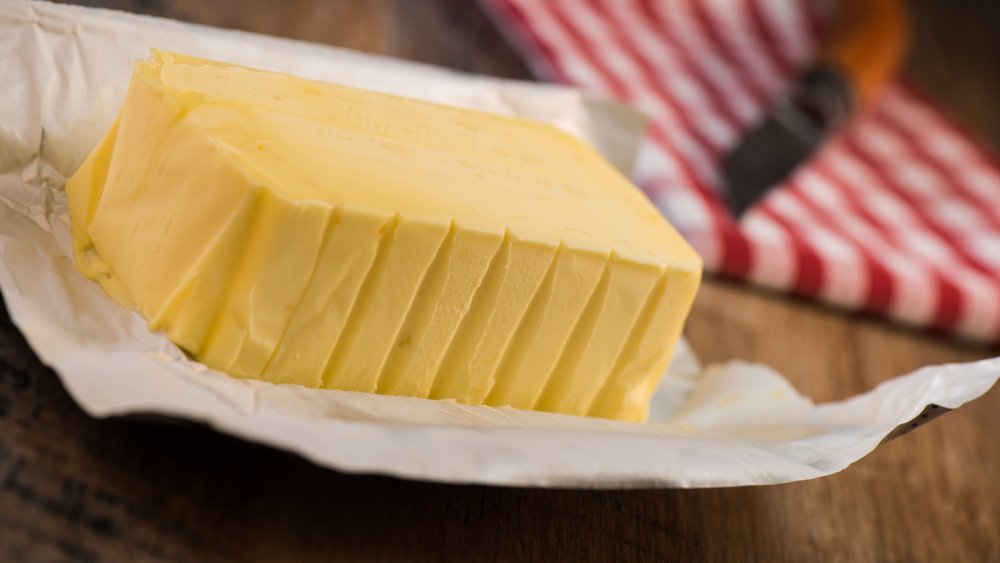The Real Difference Between Irish Butter And Regular Butter
If America's various crimes against food mean we can't have nice things made in the USA, then butter is no exception. And as many discerning grocery shoppers know, Irish butter — particularly Kerrygold — rules over all. It's silky, creamy, and just the right balance of salty and sweet. But what makes Irish butter so udder-ly (sorry) superior to bland American varieties?
For one, it's the color. Irish butter is often a satisfying shade of yellow that's deeper than most regular butter brands. We tend to eat with our eyes first, and yellow is the color most fast-food marketers choose for a reason: it's associated with comfort and contentment (via Insider). That yellow in Irish butter, though, isn't just coloring like annatto, used to brighten up foods like Velveeta and Goldfish — it comes from the beta-carotene Irish cows ingest in Irish pastures, which then makes its way into their stored fat — and then their milk (via Real Simple). Beta-carotene is naturally found in plants, like grass, and the Irish climate in particular tends to help the grass these cows dine on become a vibrant green.
"The green land is our competitive advantage," Pat O'Keeffe, deputy editor ofIrish Farmers Journal, tells NPR. "Those rolling green hills are great for growing grass. You need frequent and regular rainfall, and we've got plenty of that."
Irish butter is far more spreadable
Next up, that superior texture. Because what's just as bad as burnt toast? Impatient butterers know: It's ripped toast. You know what happens when you try to spread that cold, second-rate, white butter onto a fragile slice of your favorite bread, and that experience probably makes you not want a repeat the next time you try to butter your bread.
If you've ever had the pleasure of using Irish butter, though, you know your toast isn't destined for that sad fate. As if by magic, Irish butter is softer and more spreadable than ours. This comes down to a higher fat content (and a better nutritional profile), according to Real Simple and Everyday Health. European butter contains about 82 percent butterfat, while ours tops out at 80 percent. That extra 2 percent is usually made up of fat, which helps the butter become the delectable, spreadable texture you know and love.
Irish butter's superiority in one creamy secret
Irish cows are grass-fed, which gives their milk an advantage over our cows. Butter from cows fed mostly grass — green, not dried — gives the end product a richer, more intense flavor that ends up getting higher ratings than regular butter by those who try it. American dairy cows eat a lot of dried grasses, corn, and other seeds, grains, and food byproducts, one USDA info sheet shows, which doesn't impart the same color or taste as primarily grass-fed cows in Irish pastures, which are known for being particularly green and lush.
According to O'Keefe, there is a discernible difference in taste and mouthfeel between Irish and American butter. "I have to be careful for an American audience, but we'd say it's [like the difference between] chalk and cheese," he said.
The higher fat content, grass-fed milk, golden color, and luscious texture set Kerrygold and other Irish butters miles apart from regular American brands like Land O' Lakes or even organic brands like Horizon. By some accounts, Irish butter has an advantage over other European butters, too, which strive for the same bight, sunny color, and luxurious taste.
Grass-fed butter tends to be more nutritious, too
Grass-fed butter, like Irish butter, tends to actually have a better nutritional profile as well. According to Everyday Health, there could be more omega-3 fatty acids in your pat of Irish butter when compared to regular butter. Also, a study from 2015 found that this type of butter could have less saturated fat, and more polyunsaturated fat, than your old standby.
Another nutritional boon found in grass-fed butter is higher amounts of conjugated linoleic acid, which, in combination with the higher amounts of omega-3 fatty acids, can help to lower your risk of heart disease.
While this info could make you want to add more butter than you normally would to your favorite dishes, keep in mind that butter, no matter its origin, isn't exactly the healthiest fat out there, so keep your portions small. Also, keep in mind that while there may be a little nutritional benefit when compared to regular butter, but that doesn't mean you should use more than you normally would.
If all that's not an excuse to try some Irish butter, we don't know what is.



